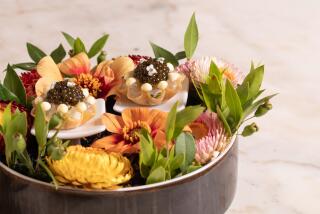Eatery Hot on Cajun Cuisine : Jilly’s Is No Flash in the Blackened Pan
- Share via
Oscar Wilde, the master of aphorisms, endowed one of his characters with the immortal line, “I’m not young enough to know everything.”
There are days when this comment, as preciously cute as it is, seems all too reasonable to me, because the more I learn about the restaurant business, the more I wonder what really makes it tick.
Generalizations are, of course, grand and wonderful, but when it comes to accurately explaining why one restaurant succeeds while its neighboring competitor fails, generalizations are less than satisfactory.
A number of acquaintances lately have mentioned Jilly’s as an especially attractive eatery. When this midtown establishment (in truth, it sits in a kind of gastronomic No Man’s Land between downtown and Hillcrest) opened three years ago, it was unusually attractive because it did fill several niches at once.
The first of these simply was geographical, but more importantly, Jilly’s was the kind of chic-but-casual neighborhood place in which other cities are rich, but which San Diego notoriously lacks. And at that time, it not only made a specialty of the then-fashionable Cajun cuisine, but also did it well. The reasonable prices that went hand-in-hand with the neighborhood atmosphere were the icing on the cake.
Today, Jilly’s seems as popular as ever, having retained its comfortable mood and its equally comfortable prices. The surprise is that it also has maintained its Cajun orientation, because in San Diego, that style of cooking, overwrought and overdone by restaurant cooks who had not the faintest idea of the principles behind it, quickly became a kind of gastronomic Edsel.
Cookbooks that purported to explain the essence of the true Louisiana cooking were largely to blame, and cooks who were wont to burn dishes found themselves suddenly vindicated by the new “blackened” dishes introduced by that rotund New Orleans prophet, Paul Prudhomme.
Good cooks, of course, will feel their way through recipes and not blindly follow the dictums of some flash-in-the-pan guru, but indiscriminately blackened dishes became so dishearteningly ubiquitous that the term Cajun finally became synonymous with vulcanized flesh. The pity of all this is that real Louisiana cooking is superb.
Jilly’s chef/proprietor Michael Jackson (whose wife, Jill, gives her name to the establishment and her services to the dining room) did, however, manage to tiptoe successfully through the putative Cajun mine field, and continues to do so today with reasonable success.
His wonderful fried chicken salad has vanished from the menu, but the Louisiana influence continues in such dishes as pecan-breaded salmon in a buttery pecan sauce, a jambalaya of shrimp and chicken, sauteed herbed catfish, and blackened filet mignon and fish. Cajun accents (such as a scattering of scallion greens atop a dish of pasta, and a bit of spicy andouille in the lentil soup) appear elsewhere in the menu. The cooking in any case is largely if not unexceptionably commendable, and Jackson’s understanding of herbs and other flavoring agents remains impressive.
Among the appetizers, the breaded eggplant and mozzarella sticks are a bit too reminiscent of the common ice-breaker served in the dine ‘n’ date dives in Mission Valley, but the marinated shrimp in lime vinaigrette with chilis, olives and avocados is an interesting dish, as is the heartier plate of marinated, grilled beef tenderloin slices.
A good way to start, if one has a companion amenable to tenderloin in a so-called New Orleans marinara sauce.
The yellowtail certainly was a minor triumph, the fish deliciously smoky from the grill, and richly moist under its light cloak of butter flavored with sage, rosemary and lime. If rosemary seems a strong flavoring for fish, consider that yellowtail has the character to stand up to it. An attractive assortment of lightly cooked vegetables took up another third of the plate, the remainder being occupied by an equally attractive mound of basmati rice, cooked al dente and treated to the merest whiff of curry powder. The plate was without fault.
The blackened veal, on the other hand, proved a failed exercise in culinary sophistry. The mere thought of first coating so mild a meat as veal in strong spices, and then torturing it in an incandescent skillet, seems ludicrous; to actually do it is ludicrous. The meat, charred beyond recognition, had no flavor of its own and was rendered quite dry by the process. To make matters worse, so much cayenne pepper was used that, after the second bite, this writer’s ears burned, and that is the simple, unvarnished truth.
But since several blackened dishes appear on the menu, there must be a market for them, and it would seem that Jackson at present has this market cornered.
The dessert list features a couple of cheesecakes and, perhaps more characteristically, a chocolate pecan pie that is less rich than most, but still satisfactory.
Beyond the food, Jilly’s is recommendable for its atmosphere, which is of the quietly sophisticated, urban oasis sort. Everything is soft but chic, from the gray and pink color scheme to the jazz tapes that play quietly in the background. Service is cheerful and efficient.
JILLY’S.
5th Avenue at Hawthorn Street, San Diego.
544-0940.
Lunch served Monday through Friday, dinner Monday through Saturday. Closed Sunday.
Credit cards accepted.
Dinner for two, including a moderate bottle of wine, tax and tip, $35 to $60.
More to Read
Eat your way across L.A.
Get our weekly Tasting Notes newsletter for reviews, news and more.
You may occasionally receive promotional content from the Los Angeles Times.










